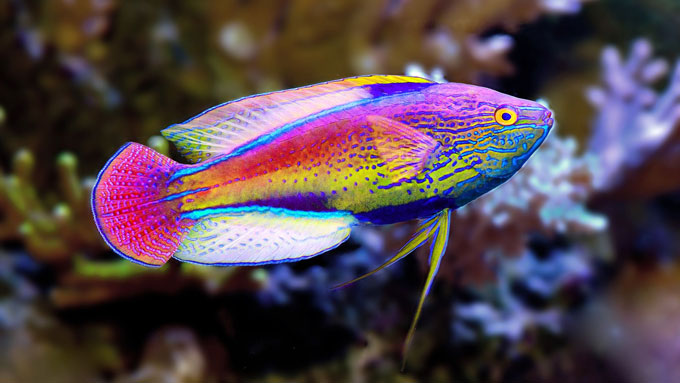This post was originally published on this site
Fairy wrasses are swimming jewels, flitting and flouncing about coral reefs. The finger-length fishes’ brash, vibrant courtship displays are meant for mates and rivals, and a new study suggests that the slow waxing and waning of ice sheets and glaciers may be partly responsible for such a variety of performances.
A new genetic analysis of more than three dozen fairy wrasse species details the roughly 12 million years of evolution that produced their vast assortment of shapes, colors and behaviors. And the timing of these transformations implies that the more than 60 species of fairy wrasses may owe their great diversity to cyclic sea level changes over the last few millions of years, scientists report February 23 in Systematic Biology.
Within the dizzying assembly of colorful reef fishes, fairy wrasses (Cirrhilabrus) can’t help but stand out. They are the most species-rich genus in the second most species-rich fish family in the ocean, says Yi-Kai Tea, an ichthyologist at the University of Sydney.
“That is quite a bit of biodiversity,” says Tea, who notes that new fairy wrasse species are identified every year. Despite this taxonomic footprint, Tea says, scientists knew “next to nothing” about the fairy wrasses’ evolutionary history or why there were so many species.
To fill this knowledge gap, Tea and his colleagues turned to the fishes’ genetics, extracting DNA from 39 different fairy wrasse species. Many earlier genetic studies on ocean animals in the region focused on a handful of genes in single species, but Tea and his team used a method that isolated nearly 1,000 genes from many species at once. Comparing DNA across species, the researchers reconstructed an evolutionary tree, showing how the dozens of fairy wrasse species are interrelated. The team also estimated how long ago these species split from one another.
Fairy wrasses diverged from other wrasses about 12 million years ago in the Miocene Epoch, the researchers found. But many of the fairy wrasse species emerged only about 1 million to 3 million years ago, in the Pleistocene and late Pliocene Epochs. Fairy wrasses appear to have first evolved in the Coral Triangle, a region of exceptionally high coral reef biodiversity in the western Pacific Ocean. From there, the fishes exploded into many gaudy forms, spreading as far as the coast of East Africa to French Polynesia, a geographical range of some 17,000 kilometers.
Tea and his colleagues think the timing of this rapid evolution is tied directly to the geologic history of the region.
The Indo-Australian Archipelago sits at the confluence of the Indian and Pacific Ocean basins — today, a spattering of islands strung between Asia and Australia. Tea describes this boundary as a “soft barrier,” with the spaces between islands occasionally allowing seafaring species to pass through to the neighboring ocean realm.
But during the Pliocene and Pleistocene Epochs — when many fairy wrasses diversified — ice ages dramatically changed this seascape. When water became locked up in expansions of ice sheets and glaciers, sea level fell, turning shallow reefs into land bridges. Such changes may have allowed human ancestors to access Indonesia and Australia (SN: 1/9/20), but they also cut off the movement of marine life. This isolation encouraged the evolution of new species on either side of the barrier.

When the glaciers melted again, the waters rose, and the fishes could once again intermix. The rising and falling seas could act like a “species pump,” Tea explains, creating new fairy wrasse species and churning them out into the world every time the barrier dissolved. The team estimates that fairy wrasses infiltrated the Indian Ocean at least five different times this way.
The findings fit into an emerging picture of the region as an engine of biodiversity in tropical seas. Genetic differences between Indian and Pacific Ocean populations have been documented in everything from sea stars to giant clams, notes Paul Barber, an evolutionary biologist at the University of California, Los Angeles not involved with this research. Such divergences are signs of temporary isolation on either side of the Indo-Australian Archipelago.
Glacial cycles “get missed sometimes in explanations of the diversification of fishes, particularly in the tropics,” says Lauren Sallan, a paleobiologist at the University of Pennsylvania also not involved with this research. “That aspect just isn’t brought up enough.”
The fairy wrasses’ elaborate mating rituals might also be why there are so many different species, Tea says.
Since the wrasses live in large, mixed-species schools, the males are under extra pressure to not only attract a mate, but to make sure she’s of the correct species. A performance with a recognizable arrangement of colors — and in some cases, fluorescence (SN: 5/29/14) — would come in handy. Going that extra mile to find the right species might make crossbreeding less likely, but also encourages reproductive isolation. Over time, small genetic changes accumulate in each isolated group, so that the two wrasses become fundamentally different species, dissimilar in their DNA, appearance and behavior.
“These patterns of fluorescence and colors are very species specific,” says Tea, who explains that there’s “heaps” left to explore about fairy wrasses, especially when it comes to how they choose mates and the evolution of their colors.
“You can dedicate your entire career to this if you wanted to and probably still never learn everything there is to learn with these amazing fishes.”
